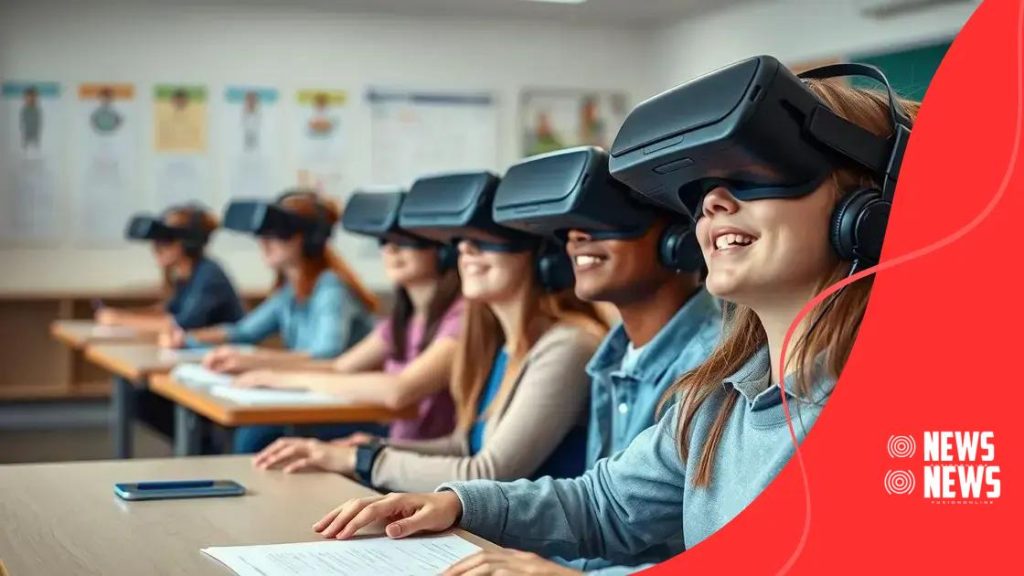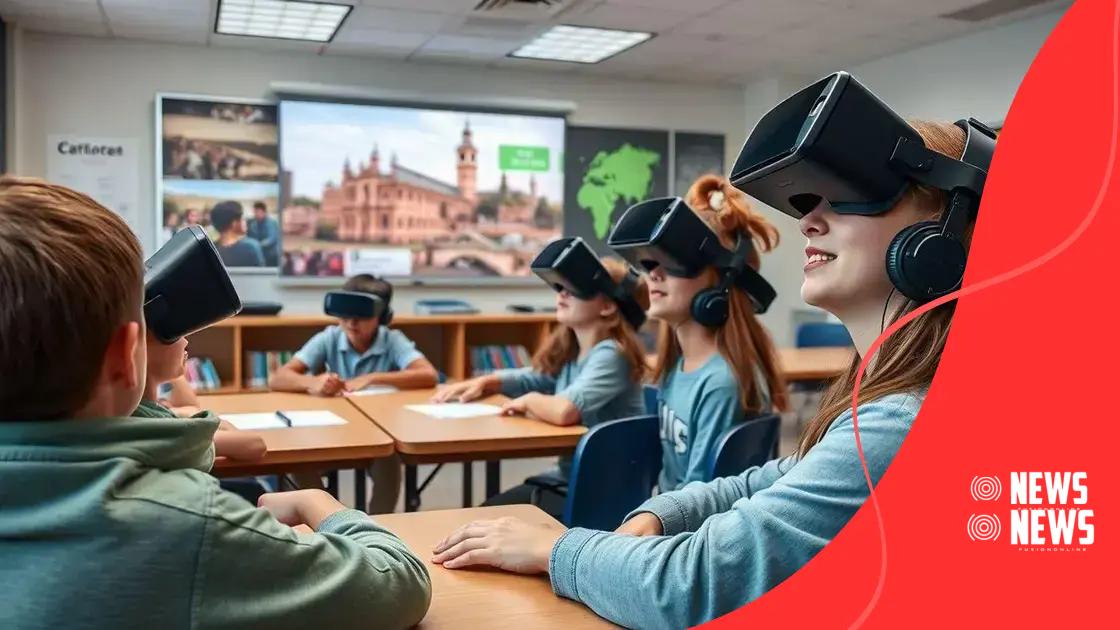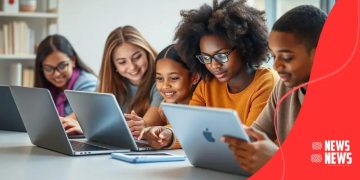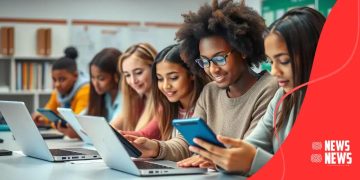Virtual reality in classrooms: improve student engagement

Virtual reality in classrooms enhances learning experiences by fostering engagement, improving retention, and providing immersive interactive environments tailored to various learning styles.
Virtual reality in classrooms is transforming how students learn and interact with educational content. Imagine stepping into ancient Rome or exploring the human body from the inside out; these experiences can captivate students like never before.
Understanding virtual reality technology
Understanding virtual reality technology is essential for educators looking to enhance learning experiences. This technology immerses users in a simulated environment, significantly improving engagement and retention.
How Virtual Reality Works
Virtual reality (VR) operates using a combination of hardware and software. Users wear VR headsets, which display 3D visuals and track head movements, providing a sense of presence in a digital space.
Key Components of VR
- Headset: A device worn on the head that displays high-definition visuals.
- Controllers: Handheld devices that allow users to interact with the virtual environment.
- Tracking Sensors: These capture movement, ensuring that the virtual experience adjusts as the user moves.
- Computer or Console: This runs the software, generating the immersive environment.
This blend of technology creates a truly immersive experience. Imagine students exploring the depths of the ocean or walking through historical landmarks! Such experiences can make learning memorable.
Moreover, the applications of virtual reality in classrooms are vast. With this technology, teachers can develop customized lessons that appeal to different learning styles. Visual learners benefit from rich graphics, while kinesthetic learners engage through interaction.
As educators adopt this technology, it’s crucial to grasp its full potential. Understanding virtual reality goes beyond merely using a headset; it’s about integrating it into educational curricula to foster deeper understanding and curiosity.
Benefits of virtual reality in education
The benefits of virtual reality in education are transforming how students engage with learning material. This innovative technology makes lessons more interactive and immersive, leading to better understanding.
Enhanced Engagement
Virtual reality captures students’ attention in a way that traditional methods cannot. Imagine walking through a historical site or exploring the solar system! These experiences keep students motivated and eager to learn.
Improved Retention
With VR, students are not just passive recipients of information. They actively participate and explore, which enhances memory retention. Studies show that students learn better when they can visualize concepts.
Personalized Learning Experience
- Customizable Lessons: Educators can tailor VR content to meet diverse learning needs.
- Multiple Perspectives: Students can see situations from various viewpoints, enhancing their understanding.
- Safe Learning Environments: Mistakes can be made in a virtual space without real-world consequences.
- Accessibility: VR can make learning accessible for students with disabilities by adapting experiences to their needs.
As technology advances, the creation of virtual reality educational tools continues to grow. This expansion offers endless possibilities for curriculum development that can engage and support students.
Furthermore, VR facilitates collaboration among students. When learners work together in a virtual space, they develop teamwork skills that are crucial for their future careers. Sharing experiences within a VR environment allows for deeper discussions and insights.
Real-world examples of VR in classrooms

Exploring real-world examples of VR in classrooms demonstrates the technology’s powerful impact on education. Several schools are adopting virtual reality to enhance student engagement and learning outcomes.
Case Study: Virtual Field Trips
Many educators are using VR for virtual field trips, allowing students to visit places they cannot physically reach. For instance, students can travel to the Great Wall of China or the Louvre Museum right from their classroom. This unique experience broadens their horizons and enriches their understanding of different cultures.
Immersive Science Learning
In science classes, virtual reality enables students to explore complex concepts like the human anatomy or planetary systems interactively. By navigating through a 3D model of the human heart, for example, students can learn about its functions in a way that textbooks cannot provide.
Interactive History Lessons
- Historical Reenactments: Some schools use VR to simulate historical events, giving students a first-person perspective.
- Time Travel: With virtual timelines, students can experience key moments in history as if they were there.
- Exploration: Imagine walking through ancient civilizations or important battles in a virtual environment!
These examples illustrate how VR makes history come alive, fostering deeper connections and inspiring students to learn more.
Furthermore, in language classes, VR is being used to create immersive environments. Students practice language skills by interacting with virtual characters. They can order food in a French café or engage in conversations with native speakers. Such methods build confidence and enhance their communication abilities.
As more schools implement VR, the variety of applications continues to expand, showing the endless possibilities this technology offers for improving education.
Challenges of implementing VR in schools
The challenges of implementing VR in schools are significant yet manageable. As schools explore this technology, they encounter several obstacles that need addressing to make the most of virtual reality.
Cost and Budget Constraints
One major challenge is the cost associated with VR technology. High-quality headsets and software can be expensive, making it difficult for schools with limited budgets to invest in this innovation. Additionally, ongoing costs for updates and maintenance can be a burden for many educational institutions.
Training and Support
Another challenge is the need for training teachers and staff to effectively use VR. Without proper instruction, the technology might not be integrated into lesson plans effectively. Professional development programs are necessary, but they require time and resources that schools may not have. Ensuring that educators feel comfortable with the technology is crucial.
Technical Limitations
- Infrastructure: Many schools may lack the required infrastructure for VR, such as high-speed internet connections.
- Device Compatibility: Compatibility issues between different devices can cause disruptions in implementation.
- Technical Support: Schools often need reliable technical support for troubleshooting and maintenance.
- Space Requirements: VR activities may require designated spaces for safe use, which some schools might not have available.
Furthermore, not every student may respond positively to VR experiences. Some may experience motion sickness or find the technology intimidating. Teachers must assess individual student needs and adapt lessons accordingly. If students do not feel comfortable, they will be less likely to engage.
Lastly, there are concerns about screen time. With a growing focus on student well-being, educators must balance the use of VR with other traditional teaching methods. Finding the right mix is essential to ensure that students benefit from virtual reality without overwhelming them with screen time.
Future trends in virtual reality for learning
Future trends in virtual reality for learning promise exciting developments that can revolutionize education. As technology advances, the integration of VR in classrooms becomes more sophisticated and widespread.
Greater Accessibility
One trend is the move toward making virtual reality experiences more accessible. As VR technology becomes cheaper and more user-friendly, more schools can adopt it. This means that students from various backgrounds will have equal opportunities to benefit from immersive learning experiences.
Increased Integration with AI
An emerging trend is the combination of VR with artificial intelligence. This integration can lead to personalized learning pathways tailored to individual student needs. AI can analyze how students interact with VR content, providing insights and adapting lessons based on their performance.
Collaboration and Social Learning
- Virtual Classrooms: More educational platforms will offer virtual classrooms where students can learn together, regardless of location.
- Peer Interactions: Collaborative VR experiences can encourage teamwork by allowing students to work on projects together in a virtual setting.
- Global Connections: Students will connect with peers from around the world, gaining diverse perspectives on content.
This collaborative nature not only enhances learning but also builds essential social skills. Students will learn to communicate and collaborate effectively in a digital environment.
Additionally, gamification is expected to play a significant role in future VR learning experiences. Incorporating game elements can make learning more engaging, encouraging students to participate actively. By turning lessons into interactive challenges, educators can drive motivation and improve retention rates.
As these trends develop, educators and policymakers must remain informed to implement the best practices. This awareness will enable them to harness the full potential of **virtual reality in education**, ensuring it meets students’ needs effectively.
FAQ – Frequently Asked Questions about Virtual Reality in Classrooms
What are the main benefits of using virtual reality in education?
Virtual reality enhances engagement, improves retention, and provides immersive experiences that traditional teaching methods cannot offer.
How can virtual reality support different learning styles?
VR offers customizable experiences that cater to visual, auditory, and kinesthetic learners, allowing students to engage at their own pace.
What challenges do schools face when implementing VR?
Challenges include high costs, the need for teacher training, and technical limitations such as infrastructure requirements.
What is the future of virtual reality in education?
The future includes greater accessibility, integration with artificial intelligence, and enhanced collaborative learning environments.





